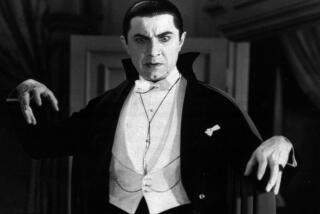A ‘Psycho’ Carves Path From Novel to Screen
- Share via
Suppose, just suppose, we take “American Psycho” at its word and agree that this little number is, in the words of director and co-writer Mary Harron, “a comedy, a satire on the late 1980s.” The question becomes: a) How sharp and penetrating a satire is it?, and b) Are the pungency of its barbs worth what must be endured to receive them? The answers: not very and definitely not.
Even for argument’s sake, it’s tough to imagine a hypothetical viewer coming out of this Harron-Guinevere Turner adaptation of the Bret Easton Ellis novel, smacking a forehead with the palm of one hand and exclaiming: “The 1980s! A decade of excess! Who knew! People consumed by possessions and status and making a mockery of conventional morality and enduring human values! I had no idea!”
Could such a cave-dweller be found, who would want to subject him (or her) to “American Psycho’s” particular brand of enlightenment? Promotional blather about its satiric thrusts notwithstanding, the bottom line is that this film is 100 minutes spent with an unpleasant, unmotivated, disconnected psychopath named Patrick Bateman (Christian Bale), who enjoys hacking folks into pieces and storing body parts in a freezer. Which is pretty much 100 minutes too many.
Perhaps knowing what it was up against, “American Psycho” has taken considerable pains to look its best. Coolly photographed by Andrzej Sekula (“Pulp Fiction”) with production design by Gideon Ponte, this has to be one of the most elegant films ever made about someone who relishes chopping people up. Its characters live in a world of designer labels and chic restaurants and clubs and the film has certainly got that part right.
Also, to be fair, “American Psycho” is not as violent as it could be; director Harron, content to be up to her ankles in bloody doings rather than hip-deep, often forgoes the most gruesome shots. Still, even with this forbearance, there’s so much carnage here that only an organization as penny-wise and pound-foolish as the MPAA could have horse-traded it down from an NC-17 (and that for sex, not violence) to its current R.
Harron starts the film with a bit of a visual joke, with bright red drops that turn out to not be what we’re nervously expecting. Bateman and his Wall Street cronies are discovered at a pricey Manhattan restaurant, making sarcastic, snotty remarks and covering all sins, as well as the bill, with a shower of American Express platinum cards.
As played by Bale (a young British actor who looks a bit like Ellis’ current author photo), the 27-year-old Bateman is the ultimate product of a society obsessed with consuming. Faultlessly groomed but empty of all feeling, he may say “I believe in taking care of myself,” but in truth there’s no self to take care of. Bateman is simply a healthy corpse who is accurate when he says, “There is no real me. I simply am not there.”
While Bateman’s grasping girlfriend, Evelyn Williams (Reese Witherspoon), is determined to get married, Bateman is more interested in cheating on her with her comatose best friend, Courtney Rawlinson (Samantha Mathis). Bateman has barely disguised contempt for his contemporaries, including rival Paul Allen (Jared Leto), uncomplicated secretary Jean (Chloe Sevigny) and co-workers who produce silver cases to compare expensive business cards the way the Sharks and the Jets pulled out switchblade knives once upon a time.
Unfortunately for us, the only way Bateman can feel alive is to kill and kill again. He starts with a few men, but soon enough women become his victims of choice, so much so that he breaks out the chain saw when they’re around. While Ellis’ novel was criticized for being misogynistic, Bateman and his pals are so uniformly hateful and heartless (more like the Ripley of the Patricia Highsmith novel than the recent film) that “American Psycho” feels equally guilty of the opposite sentiment, man-hating misandry.
Judging by the hilarity with which they spoke about it at its Sundance Film Festival debut, Harron and her collaborators had a high old time playing around with “American Psycho’s” blood and body parts, but this kind of carnage is not nearly as much fun to experience on the screen and most audiences will likely feel left out of the joke.
Similarly, the games the film plays as to whether these murders are real (Willem Dafoe plays an investigator) or simply Bateman’s fantasies come off as seriously beside the point. We have to experience these uncomfortable events as if they were flesh-and-blood happenings, and that is what matters. The difficult truth is that the more viewers can model themselves after protagonist Bateman, the more they can distance themselves from the human reality of the slick violence that fills the screen and take it all as some kind of a cool joke, the more they are likely to enjoy this stillborn, pointless piece of work.
* MPAA rating: R, for strong violence, sexuality, drug use and language. Times guidelines: numerous graphic killings.
‘American Psycho’
Christian Bale: Patrick Bateman
Willem Dafoe: Donald Kimball
Jared Leto: Paul Allen
Reese Witherspoon: Evelyn Williams
Samantha Mathis: Courtney Rawlinson
Chloe Sevigny: Jean
Released by Lions Gate Films. Director Mary Harron. Producers Edward R. Pressman, Chris Hanley, Christian Halsey Solomon. Executive producers Michael Paseornek, Jeff Sackman, Joseph Drake. Screenplay Mary Harron & Guinevere Turner, based on the novel by Bret Easton Ellis. Cinematographer Andrzej Sekula. Editor Andrew Marcus. Costumes Isis Mussenden. Music John Cale. Production design Gideon Ponte. Art director Andrew Stearn. Running time: 1 hour, 40 minutes.
In general release throughout Southern California.
More to Read
Only good movies
Get the Indie Focus newsletter, Mark Olsen's weekly guide to the world of cinema.
You may occasionally receive promotional content from the Los Angeles Times.











